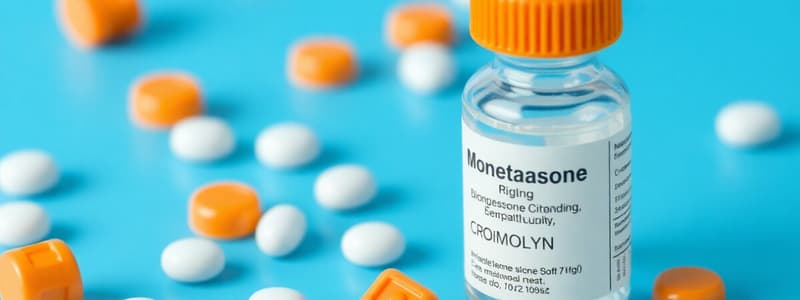Podcast
Questions and Answers
What is the primary mechanism of action of mometasone in treating allergic rhinitis?
What is the primary mechanism of action of mometasone in treating allergic rhinitis?
- Blocking histamine receptors to alleviate symptoms.
- Stabilizing mast cells to prevent histamine release.
- Decongesting nasal passages by constricting blood vessels.
- Reducing inflammation by inhibiting the release of inflammatory mediators. (correct)
A patient using mometasone for allergic rhinitis reports experiencing frequent nosebleeds. What is the most appropriate initial recommendation?
A patient using mometasone for allergic rhinitis reports experiencing frequent nosebleeds. What is the most appropriate initial recommendation?
- Reduce the dosage of mometasone and use a nasal saline spray to moisten the nasal passages. (correct)
- Add an oral decongestant to counteract the nosebleeds.
- Discontinue mometasone use immediately and switch to an antihistamine.
- Increase the dosage of mometasone to reduce inflammation more effectively.
Which allergic symptom is mometasone most effective in treating?
Which allergic symptom is mometasone most effective in treating?
- Nasal congestion and inflammation associated with allergic rhinitis. (correct)
- Bronchospasm and wheezing due to allergic asthma.
- Immediate relief from acute urticaria (hives).
- Gastrointestinal symptoms related to food allergies.
What is the mechanism of action of cromolyn sodium in managing allergic symptoms?
What is the mechanism of action of cromolyn sodium in managing allergic symptoms?
A patient using a cromolyn nebulizer reports experiencing a burning sensation in their throat. What is the proper course of action?
A patient using a cromolyn nebulizer reports experiencing a burning sensation in their throat. What is the proper course of action?
Which allergic symptom is cromolyn primarily used to manage?
Which allergic symptom is cromolyn primarily used to manage?
What is a significant limitation associated with cromolyn use for allergy management?
What is a significant limitation associated with cromolyn use for allergy management?
A patient is prescribed both intranasal mometasone and intranasal cromolyn. How should they be advised to use these medications?
A patient is prescribed both intranasal mometasone and intranasal cromolyn. How should they be advised to use these medications?
Which of the following is a common adverse effect associated with intranasal cromolyn but NOT with mometasone?
Which of the following is a common adverse effect associated with intranasal cromolyn but NOT with mometasone?
Why is adherence to the prescribed regimen particularly important for patients using cromolyn?
Why is adherence to the prescribed regimen particularly important for patients using cromolyn?
Which statement best describes the mechanism by which mometasone reduces allergic rhinitis symptoms?
Which statement best describes the mechanism by which mometasone reduces allergic rhinitis symptoms?
A patient with severe seasonal allergies is not responding adequately to intranasal mometasone. What is the most appropriate next step in managing this patient's symptoms?
A patient with severe seasonal allergies is not responding adequately to intranasal mometasone. What is the most appropriate next step in managing this patient's symptoms?
A patient using intranasal mometasone complains of a persistent sore throat and hoarseness. What is the most likely cause?
A patient using intranasal mometasone complains of a persistent sore throat and hoarseness. What is the most likely cause?
Which aspect of allergic rhinitis is mometasone LEAST effective in treating?
Which aspect of allergic rhinitis is mometasone LEAST effective in treating?
How does cromolyn sodium prevent allergic reactions at the cellular level?
How does cromolyn sodium prevent allergic reactions at the cellular level?
A patient using a cromolyn nebulizer for asthma reports developing a persistent dry cough. What is the most appropriate intervention?
A patient using a cromolyn nebulizer for asthma reports developing a persistent dry cough. What is the most appropriate intervention?
For which specific allergic symptom is cromolyn considered a first-line treatment?
For which specific allergic symptom is cromolyn considered a first-line treatment?
What is the primary limitation of cromolyn sodium compared to other allergy medications like antihistamines and corticosteroids?
What is the primary limitation of cromolyn sodium compared to other allergy medications like antihistamines and corticosteroids?
A patient is using both intranasal mometasone and intranasal cromolyn for seasonal allergies. What instruction regarding their use is MOST important?
A patient is using both intranasal mometasone and intranasal cromolyn for seasonal allergies. What instruction regarding their use is MOST important?
Why is patient education regarding proper administration technique particularly critical for cromolyn, compared to other intranasal medications?
Why is patient education regarding proper administration technique particularly critical for cromolyn, compared to other intranasal medications?
Flashcards
Mometasone MOA
Mometasone MOA
Reduces inflammation in the nasal passages by inhibiting the release of inflammatory mediators.
Mometasone Adverse Effects
Mometasone Adverse Effects
Local irritation, nosebleeds, headache.
Symptoms Mometasone Treats
Symptoms Mometasone Treats
Nasal congestion, sneezing, runny nose, itchy nose.
Cromolyn MOA
Cromolyn MOA
Signup and view all the flashcards
Cromolyn Adverse Effects
Cromolyn Adverse Effects
Signup and view all the flashcards
Cromolyn Treatable Symptoms
Cromolyn Treatable Symptoms
Signup and view all the flashcards
Cromolyn Use Issues
Cromolyn Use Issues
Signup and view all the flashcards
Study Notes
- Mometasone is an intranasal corticosteroid.
Mometasone
- Mechanism of Action: It reduces inflammation.
- Adverse Effects: Can lead to local irritation, nosebleeds, and rarely, systemic effects.
- Allergic Symptoms: Effective for nasal congestion, sneezing, and runny nose.
Cromolyn
- Cromolyn is a mast cell stabilizer.
- Mechanism of Action: Prevents the release of histamine and other inflammatory mediators from mast cells.
- Adverse Effects:
- Intranasal: Nasal irritation and stinging.
- Nebulizer: Cough and wheezing.
- Allergic Symptoms: Works best for preventing allergic rhinitis symptoms, such as sneezing and runny nose.
- Issues with Use and Administration: Requires frequent administration and is less potent than corticosteroids.
Studying That Suits You
Use AI to generate personalized quizzes and flashcards to suit your learning preferences.

